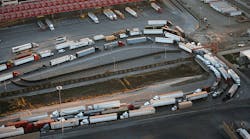In 2014, U.S. merchandise exports to Mexico reached $240.3 billion, a 147% increase since the implementation of the North American Free Trade Agreement (NAFTA), making Mexico the United States' second largest export market. For many U.S. manufacturers, selling to Mexican assembly plants along the U.S.-Mexico border has become a robust business. However, doing business is not without its challenges, and U.S. firms need to prepare themselves beforehand to maximize their success.
There's been incredible growth during the last few years in demand for suppliers of manufactured components in electronics, automotive, aviation and all types of industries. Fifteen years ago, U.S. companies tended to look only at the border region when selling their manufactured parts and components, as these firms were more reluctant to sell further into Mexico. Today, we're seeing many more U.S. companies extending their sales into the interior of Mexico—the region is coming on strong. According to projections from Business Monitor International, Mexico will produce 3.62 million vehicles in 2015, accounting for over 20% of North American vehicle production.
El Paso, Texas, is the second-largest crossing point for U.S. suppliers exporting to Mexico. Being located on the U.S. southern border makes it easier for U.S. firms to do business. We're seeing about 3,000 truckloads of U.S. goods crossing the border from El Paso to Cuidad Juarez every day.
Mexico's manufacturing sector has become very sophisticated with a strong emphasis on quality standards. Today, there are more than 450 assembly plants located in Ciudad Juarez. The U.S.–Mexico border economy is still very strong, and has completely recovered from the global recession of 2008.
Furthermore, U.S. manufacturers that have established a reputation as preferred vendors for Tier 1 assembly plants in Mexico have the skill set and are well-positioned to export to manufacturers throughout Latin America. These firms can take advantage of the U.S. Department of Commerce's Look South initiative.
Much of the growth in the U.S.-Mexico border region not only originates from NAFTA, which eliminated or lowered barriers, but also by Mexico's auto and aviation industry, which has set the pace in driving up quality standards for Mexican industry sectors. Now, most of country's industries are following suit. Years ago, one could get by with selling lower-quality components and manufactured goods into Mexico, but no more. For example, Mexican manufacturers want globally competitive suppliers who are pre-qualified and meet the international ISO 9000, TS and AS 9100 standards. Mexican companies also manage supplier development programs to pre-qualify U.S. suppliers.
We're also seeing vast improvement in the quality of the Mexican workforce—such as training in manufacturing and engineering—which is contributing to the demand for high quality manufacturing.
Managing Expectations for the Long Term
Along with Mexico's higher quality manufacturing standards, four other items of importance for U.S. firms would be managing expectations for bringing a business deal to fruition, supply, volume, and warehousing. Selling to the border region can be a long-term process depending on the size and capability of the U.S. company. Many companies, especially ones that are new to doing business in the border region, are surprised to learn that selling to Mexican manufacturers requires an enormous volume of U.S. supplier products. Larger companies in Detroit and Chicago, for example, are usually well-equipped to do this, but smaller U.S. companies less so.
What happens is that typically a U.S. company will lease community warehouses shared with other companies in Mexico to provide ample stock of its products. In addition, many smaller U.S. suppliers will focus on equipping larger U.S. suppliers that are dealing directly with the Mexican assembly plants—it's not unusual to have six or seven U.S. firms in the supply chain.
Also, geographic proximity is a huge advantage when supplying material to Mexican manufacturers. In an effort to hold down costs, many manufacturers store a small inventory, and therefore they rely on their suppliers to deliver material on a consistent schedule. This trend is driving the co-manufacturing trend that is developing between the United States and Mexico. Many foreign manufacturers in Europe and Asia have taken notice of this trend, and they are increasing investment in North America.
Border Marketing Strategies
Since El Paso and Santa Teresa, N.M., are logistics gateways for border exports, the El Paso U.S. Export Assistance Center (USEAC) assists U.S. suppliers nationwide with their border marketing strategies. There's no one-size-fits-all when it comes to assisting U.S. companies; it really depends on the individual firm. For example, some firms might need assistance in techniques to prepare a competitive quote, or achieving quality standards.
The El Paso USEAC relies on the U.S. Department of Commerce's Manufacturing Extension Partnership (MEP) program to counsel manufacturers on ISO 9000 training programs.
Other companies take advantage of the U.S. Commercial Service's Gold Key and International Partner Search services. Partner searches help U.S. companies locate marketing representatives or warehouse space to hold inventory. During the past year, the El Paso office has assisted nearly 60 U.S. companies by connecting them to prospective Mexican partners. Many of these contacts are made through the support of business-to-business matchmaking events such as ExpoMRO and ExpoPack, as well as trade shows in Ciudad Juarez and the Supply Chain Summit held in El Paso every year. At these events, American exporters can meet directly with material buyers from the Mexican manufacturing plants.
The U.S. Commercial Service also offers a program which sets up pre-arranged business appointments with distributors and agents abroad. The U.S. Consulates in Ciudad Juarez, Tijuana and Nogales assist the U.S. Department of Commerce in carrying out these services along the border.
Robert Queen is director of the U.S. Commercial Service's El Paso Export Assistance Center, and Curt Cultice is senior communications specialist with the U.S. Commercial Service of the U.S. Department of Commerce. The U.S. Commercial Service has five offices in key areas located along the U.S.-Mexico border that assist U.S. companies interested in supplying material to the maquiladora industry. These offices are located in San Antonio, El Paso, Tucson, San Diego, and Monterrey, Mexico.



